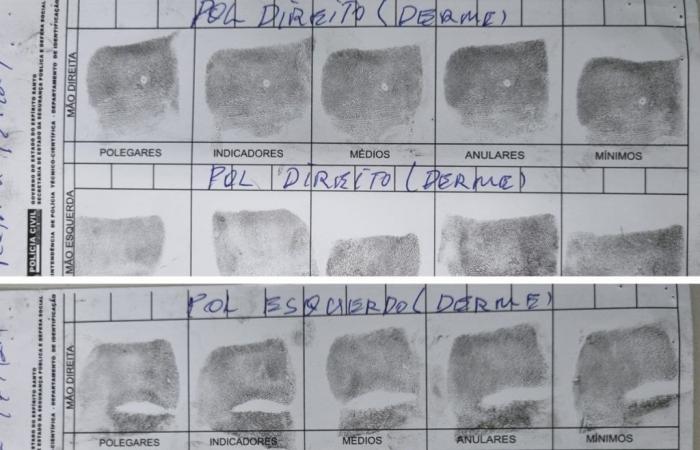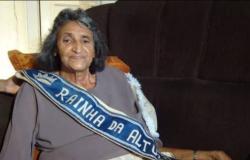
During the 24 years she was hospitalized, it was never possible to collect fingerprints from Clarinha, a mysterious patient who died on Thursday (14), in Vitória. However, this situation changed last weekend, when experts from Espírito Santo carried out a post-mortem procedure that allowed the collection of complete fingerprints for comparisons and examinations. This technique is only possible on dead people, so it was only possible to perform it now.
Clarinha’s story gained repercussion after a report about the case was shown on Fantástico, in 2016. The woman was run over on Valentine’s Day, on June 12, 2000, in the center of Vitória. From there, she was taken without documents to receive medical care, arrived unconscious and her identification was never proven by any family member. During all these years, she was hospitalized in a vegetative state in city hospitals.
Official Criminal Expert João Carlos Quemelli, from the Forensic Necropapiloscopy Laboratory of the Scientific Police of Espírito Santo (PCIES), explained that the procedure is called “excision of the phalanx”, and it was only done now because it is only performed on cadavers.
“We remove the epidermis from the thumb in a very patient and thorough way. And the fingerprint is collected from the dermis, the deepest layer of the skin. When we say that a person doesn’t have fingerprints, as was the case with Clarinha, the fingerprint doesn’t just exist in the outer layer, because of some injury, allergy… But, it still exists in the dermis, and that’s where we looked for it”, he described.
“In 2016, Clarinha’s partial fingerprints had already been collected, but in a very fragmented way, she practically had no identification. With the excision of the phalanx, we have fingerprints from both thumbs, perfect for comparison, ten samples from each finger” , continued João Carlos.
The expert reinforced that each fingerprint is unique and detailed how the comparison works in a case like this, when families present themselves. In other words: fingerprint alone is not capable of identifying with 100% certainty the existence of a possible relative.
“We cannot compare one person’s fingerprints with another, they are unrelated. What happens in these cases is a first exclusion, or not, of a relationship through comparison with existing document records”, he explained.
Clarinha dies, a patient who was hospitalized in a coma for 24 years in Vitória
“In other words, if a person comes to the DML saying that Clarinha could be their mother, we ask for the full name of this supposed mother, the name of the maternal grandparents and where this person would have been registered. From then on, we request these records, assuming who is an adult, with documents, to make the comparison with the complete fingerprints collected from Clarinha”.
João Carlos stated that with this identification process, it is possible to rule out whether or not it is the relative that the person/family that appears to the police is looking for.
“In fact, we have already ruled out two connections that appeared after the death. That of a boy from Espírito Santo who claimed to be Clarinha’s son, and that of a family from Bahia. In the case of this family, Clarinha’s fingerprints were compared with documents of the missing woman that were registered in São Paulo, and were negative. The two cases will not even go to DNA.”
According to João Carlos, experts are already aware of two other families, from Brasília and Paraná, who came forward and will have information and documents collected for identification work.
As Clarinha was an adult, experts believe that there is a comparison of fingerprints in some state, through registered documents, therefore, there is a chance of a comparison being positive. “If she is one of those rare cases with no identity in any Brazilian state, the only way to go is through DNA.”
‘Clarinha’, patient hospitalized in a coma for 24 years in a hospital in ES, dies
According to João Carlos, comparing fingerprint samples is the first option in these cases, because of the response time. “In the case of fingerprint analysis, we already have the answer on the same day. The result of a DNA test takes around 30 to 40 days”, he compared.
National Genetic Profile Bank
Official Criminal Expert Caio Nucci de Araújo, head of the Forensic DNA Laboratory of the Scientific Police of Espírito Santo (PCIES), informed that Clarinha’s genetic profile has been included in the National Genetic Profiles Bank since 2015.
“Unfortunately, to date, no family has been matched by the bank. Searches are carried out automatically when a new profile is inserted. What we do continuously, as soon as it is sent to the laboratory, is collect and process the genetic material of possible new family members.”
In Espírito Santo, 354 genetic profiles of unidentified remains are registered in the bank, in addition to four profiles of people of unknown identity – which is the case of Clarinha -, and six genetic profiles originating from direct reference of missing people, such as a brush tooth, some material unequivocally attributed to that person.
Videos: everything about the Holy Spirit
Tags: Clarinha Case Postmortem procedure collects complete fingerprints time rules relatives Holy Spirit
--




